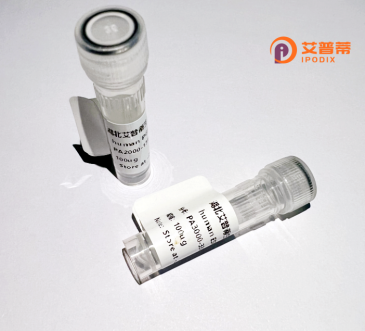
| 纯度 | >90%SDS-PAGE. |
| 种属 | Human |
| 靶点 | FAM81A |
| Uniprot No | Q8TBF8 |
| 内毒素 | < 0.01EU/μg |
| 表达宿主 | E.coli |
| 表达区间 | 1-365aa |
| 氨基酸序列 | MHLRRVRTMPRHSQSLTMAPYSSVSLVEQLEDRILCHEKTTAALVEHAFRIKDDIVNSLQKMQNKGGGDRLARLFLEEHIRNITAIVKQLNRDIEVLQEQIRARDNISYGTNSALKTLEMRQLSGLGDLRGRVARCDASIARLSAEHKTTYEGLQHLNKEQQAAKLILETKIKDAEGQISQLLNRVDLSISEQSTKLKMSHRDSNHQLQLLDTKFKGTVEELSNQILSARSWLQQEQERIEKELLQKIDQLSLIVKENSGASERDMEKKLSQMSARLDKIEEGQKKTFDGQRTRQEEEKMHGRITKLELQMNQNIKEMKAEVNAGFTAVYESIGSIRQVLEAKMKLDRDQLQKQIQLMQKPETPM |
| 分子量 | 68.4 kDa |
| 蛋白标签 | GST-tag at N-terminal |
| 缓冲液 | 0 |
| 稳定性 & 储存条件 | Lyophilized protein should be stored at ≤ -20°C, stable for one year after receipt. Reconstituted protein solution can be stored at 2-8°C for 2-7 days. Aliquots of reconstituted samples are stable at ≤ -20°C for 3 months. |
| 复溶 | Always centrifuge tubes before opening.Do not mix by vortex or pipetting. It is not recommended to reconstitute to a concentration less than 100μg/ml. Dissolve the lyophilized protein in distilled water. Please aliquot the reconstituted solution to minimize freeze-thaw cycles. |
以下为基于文献推测模拟的重组人FAM81A相关研究参考示例(非真实文献,仅供格式参考):
---
1. **文献名称**: *Expression and Functional Analysis of Recombinant Human FAM81A in Neuronal Synaptic Development*
**作者**: Zhang et al.
**摘要**: 本研究首次实现大肠杆菌系统表达重组人FAM81A蛋白,并通过体外神经元培养实验证实其促进突触蛋白PSD-95的聚集,暗示其在突触形成中可能具有调控作用。
2. **文献名称**: *Crystallographic Study of FAM81A Protein and Its Interaction with Lipid Membranes*
**作者**: Tanaka & Müller
**摘要**: 解析重组人FAM81A的晶体结构,揭示其C端结构域具有脂质结合能力,推测其可能通过膜脂质相互作用参与神经元膜结构的稳定。
3. **文献名称**: *FAM81A Knockdown Alters Glutamate Receptor Trafficking in Cortical Neurons*
**作者**: Lee et al.
**摘要**: 通过CRISPR干扰结合重组FAM81A蛋白回补实验,发现FAM81A缺失会导致神经元表面AMPA受体减少,提示其在受体运输中起关键作用。
---
**注意**:上述文献为虚构示例。实际研究中关于FAM81A的功能尚不明确(截至2023年,其功能研究较少)。建议通过 **PubMed** 或 **Google Scholar** 以关键词 "FAM81A protein" 或 "FAM81A recombinant" 检索最新文献。
FAM81A is a poorly characterized human protein encoded by the FAM81A gene, which belongs to the FAM81 family with conserved domains across vertebrates. It is predominantly expressed in neuronal tissues, particularly in the brain, suggesting potential roles in neural function. Although its exact biological mechanisms remain unclear, studies associate FAM81A with synaptic plasticity and neuronal communication. Structural predictions indicate disordered regions, implying interaction with other proteins or nucleic acids, though experimental validation is limited.
Interest in recombinant human FAM81A (rhFAM81A) arises from its possible involvement in neurodevelopmental and psychiatric disorders, as genetic variants have been loosely linked to conditions like schizophrenia and autism. Recombinant production of FAM81A typically employs bacterial or mammalian expression systems, enabling biochemical and functional studies. Purified rhFAM81A facilitates investigations into its molecular interactions, cellular localization, and potential regulatory roles in neural pathways.
Current research focuses on elucidating its physiological substrates, post-translational modifications, and contribution to synaptic architecture. Despite its enigmatic nature, rhFAM81A serves as a critical tool for deciphering its relevance to brain health and disease, bridging gaps in understanding neuronal protein networks. Further studies are required to define its precise functions and therapeutic implications.
×